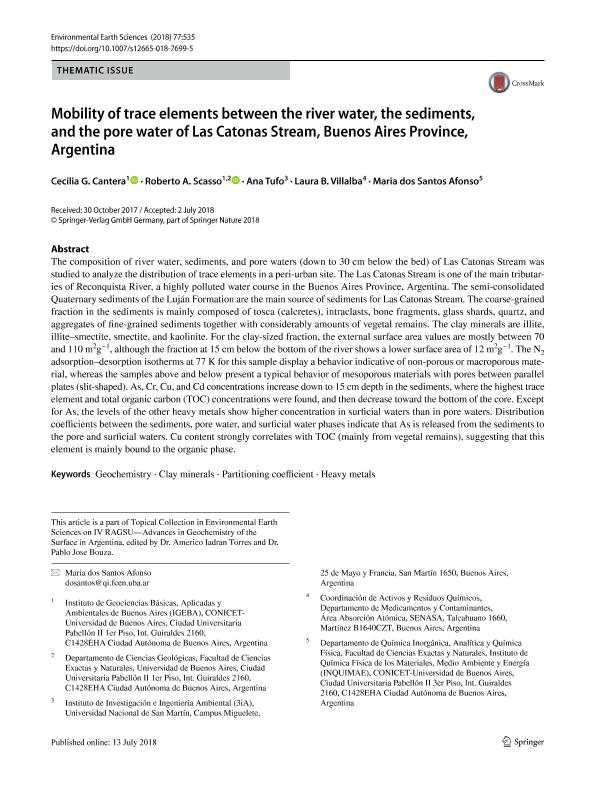Mostrar el registro sencillo del ítem
dc.contributor.author
Cantera, Cecilia Gisela

dc.contributor.author
Scasso, Roberto Adrian

dc.contributor.author
Tufo, Ana Elisabeth

dc.contributor.author
Villalba, Laura Belén

dc.contributor.author
Dos Santos Afonso, María

dc.date.available
2020-03-11T20:05:12Z
dc.date.issued
2018-07
dc.identifier.citation
Cantera, Cecilia Gisela; Scasso, Roberto Adrian; Tufo, Ana Elisabeth; Villalba, Laura Belén; Dos Santos Afonso, María; Mobility of trace elements between the river water, the sediments, and the pore water of Las Catonas Stream, Buenos Aires Province, Argentina; Springer Verlag Berlín; Environmental Earth Sciences; 77; 14; 7-2018; 1-10
dc.identifier.issn
1866-6280
dc.identifier.uri
http://hdl.handle.net/11336/99199
dc.description.abstract
The composition of river water, sediments, and pore waters (down to 30 cm below the bed) of Las Catonas Stream was studied to analyze the distribution of trace elements in a peri-urban site. The Las Catonas Stream is one of the main tributaries of Reconquista River, a highly polluted water course in the Buenos Aires Province, Argentina. The semi-consolidated Quaternary sediments of the Luján Formation are the main source of sediments for Las Catonas Stream. The coarse-grained fraction in the sediments is mainly composed of tosca (calcretes), intraclasts, bone fragments, glass shards, quartz, and aggregates of fine-grained sediments together with considerably amounts of vegetal remains. The clay minerals are illite, illite–smectite, smectite, and kaolinite. For the clay-sized fraction, the external surface area values are mostly between 70 and 110 m2g−1, although the fraction at 15 cm below the bottom of the river shows a lower surface area of 12 m2g−1. The N2 adsorption–desorption isotherms at 77 K for this sample display a behavior indicative of non-porous or macroporous material, whereas the samples above and below present a typical behavior of mesoporous materials with pores between parallel plates (slit-shaped). As, Cr, Cu, and Cd concentrations increase down to 15 cm depth in the sediments, where the highest trace element and total organic carbon (TOC) concentrations were found, and then decrease toward the bottom of the core. Except for As, the levels of the other heavy metals show higher concentration in surficial waters than in pore waters. Distribution coefficients between the sediments, pore water, and surficial water phases indicate that As is released from the sediments to the pore and surficial waters. Cu content strongly correlates with TOC (mainly from vegetal remains), suggesting that this element is mainly bound to the organic phase.
dc.format
application/pdf
dc.language.iso
eng
dc.publisher
Springer Verlag Berlín

dc.rights
info:eu-repo/semantics/openAccess
dc.rights.uri
https://creativecommons.org/licenses/by-nc-sa/2.5/ar/
dc.subject
CLAY MINERALS
dc.subject
GEOCHEMISTRY
dc.subject
HEAVY METALS
dc.subject
PARTITIONING COEFFICIENT
dc.subject.classification
Otras Ciencias de la Tierra y relacionadas con el Medio Ambiente

dc.subject.classification
Ciencias de la Tierra y relacionadas con el Medio Ambiente

dc.subject.classification
CIENCIAS NATURALES Y EXACTAS

dc.title
Mobility of trace elements between the river water, the sediments, and the pore water of Las Catonas Stream, Buenos Aires Province, Argentina
dc.type
info:eu-repo/semantics/article
dc.type
info:ar-repo/semantics/artículo
dc.type
info:eu-repo/semantics/publishedVersion
dc.date.updated
2020-01-30T21:57:28Z
dc.identifier.eissn
1866-6299
dc.journal.volume
77
dc.journal.number
14
dc.journal.pagination
1-10
dc.journal.pais
Alemania

dc.journal.ciudad
Berlin
dc.description.fil
Fil: Cantera, Cecilia Gisela. Consejo Nacional de Investigaciones Científicas y Técnicas. Oficina de Coordinación Administrativa Ciudad Universitaria. Instituto de Geociencias Básicas, Aplicadas y Ambientales de Buenos Aires. Universidad de Buenos Aires. Facultad de Ciencias Exactas y Naturales. Instituto de Geociencias Básicas, Aplicadas y Ambientales de Buenos Aires; Argentina
dc.description.fil
Fil: Scasso, Roberto Adrian. Consejo Nacional de Investigaciones Científicas y Técnicas. Oficina de Coordinación Administrativa Ciudad Universitaria. Instituto de Geociencias Básicas, Aplicadas y Ambientales de Buenos Aires. Universidad de Buenos Aires. Facultad de Ciencias Exactas y Naturales. Instituto de Geociencias Básicas, Aplicadas y Ambientales de Buenos Aires; Argentina
dc.description.fil
Fil: Tufo, Ana Elisabeth. Consejo Nacional de Investigaciones Científicas y Técnicas; Argentina. Universidad Nacional de San Martín. Instituto de Investigación en Ingeniería Ambiental; Argentina
dc.description.fil
Fil: Villalba, Laura Belén. Ministerio de Agricultura, Ganadería, Pesca y Alimento. Servicio Nacional de Sanidad y Calidad Agroalimentaria; Argentina
dc.description.fil
Fil: Dos Santos Afonso, María. Consejo Nacional de Investigaciones Científicas y Técnicas. Oficina de Coordinación Administrativa Ciudad Universitaria. Instituto de Química, Física de los Materiales, Medioambiente y Energía. Universidad de Buenos Aires. Facultad de Ciencias Exactas y Naturales. Instituto de Química, Física de los Materiales, Medioambiente y Energía; Argentina
dc.journal.title
Environmental Earth Sciences
dc.relation.alternativeid
info:eu-repo/semantics/altIdentifier/url/http://link.springer.com/10.1007/s12665-018-7699-5
dc.relation.alternativeid
info:eu-repo/semantics/altIdentifier/doi/http://dx.doi.org/10.1007/s12665-018-7699-5
Archivos asociados
